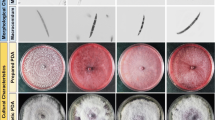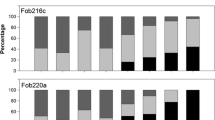Abstract
Boll rots of cotton (Gossypium hirsutum L.) are common in the humid areas of the Southeastern US. One type of boll damage that may be differentiated from others is hardlock, with symptoms that include compression of the fibers within individual locules of mature, open cotton bolls without further obvious disintegration of the lint or damage to the carpel wall. The principal economic effect is that the boll’s lint is unharvestable by mechanical cotton pickers. This disease is endemic to the Southeast and can cause severe yield losses up to 70% in some fields. Scanning electron microscopy images of fibers from hardlocked bolls showed flattened and twisted tissue compared to fibers from healthy bolls. Fusarium verticillioides (Saccardo) Nirenberg was the fungus most commonly isolated from seeds of developing cotton bolls. Flowers inoculated with F. verticillioides on the day of bloom by spraying a spore suspension onto the flowers developed significantly (P < 0.05) more hardlock symptoms compared to untreated controls. The infection process was analyzed using a F. verticillioides isolate tagged with green fluorescent protein (GFP). When it was applied to cotton flowers on the day of bloom, the GFP-tagged F. verticillioides strain was detected in the stigma and style by 2 days after bloom (DAB) and in developing seeds at 4, 6, 8, 10, 16, 20, 40, and 60 (open bolls) DAB. By 8 DAB, the GFP F. verticillioides was isolated from over 80% of developing seeds.



Similar content being viewed by others
References
Bagga HS, Laster ML (1968) A simple technique for evaluating the role of insects in cotton boll rots development. Phytopathology 58:1323–1324
Balls WL (1915) The development and properties of raw cotton. A & C Black, London, UK
Batson WE (2001) Boll rots. In: Kirkpatrick TL, Rothrock CS (eds) Compendium of cotton diseases. American Phytopathological Society, St. Paul, MN, pp 36–38
Edgerton CW (1912) Flower infection with cotton boll rots. Phytopathology 2:23–27
Farrar JJ, Davis RM (1991) Relationships among ear morphology, western flower thrips, and Fusarium ear rot of corn. Phytopathology 81:661–666
Lang AG (1938) The origin of lint and fuzz hairs of cotton. J Agric Res 56:507–521
Lee S, Kim SH, Breuil C (2002) The use of the green fluorescent protein as a biomarker for sapstain fungi. For Path 32:153–161
Lorang JM, Tuori RP, Martinez JP, Sawyer TL, Redman RS, Rollins JA, Wolpert TJ, Johnson KB, Rodriguez RJ, Dickman MB, Ciuffetti LM (2001) Green fluorescent protein is lighting up fungal biology. Appl Environ Microbiol 67(5):1987–1994
Mailhot DJ, Marois JJ, Wright DL (2007) Influence of flower thrips on Fusarium hardlock severity. Plant Dis 91:1423–1429
Marois JJ, Wright DL (2004) Etiology, epidemiology, and control of Fusarium hardlock of cotton in the southeast: the possibilities. In: Proceedings of Beltwide cotton production and research conferences, San Antonio, TX, USA. National Cotton Council of America, Omnipress, WI, USA, pp 331–336
Marsh PB, Simpson ME, Ferretti RJ, Merola GV, Dnoso J, Craig GO, Trucksess MW, Work PS (1969) Mechanism of formation of a fluorescence in cotton fiber associated with aflatoxins in the seeds at harvest. J Agr Food Chem 17(3):468–472
Medrano EG, Bell AA (2007) Role of Pantoea agglomerans in opportunistic bacterial seed and boll rot of cotton (Gossypium hirsutum) grown in the field. J Appl Microbiol 102:134–143
Medrano EG, Esquivel JF, Nichols RL, Bell AA (2009) Temporal analysis of cotton boll symptoms resulting from southern green stink bug (Nezara viridula L.) feeding and transmission of a bacterial pathogen. J Econ Entomol 102(1):36–42
Medrano EG, Esquivel J, Bell A, Greene J, Roberts P, Bacheler J, Marois J, Wright D, Nichols R, Lopez J (2009) Potential for Nezara viridula (Hemiptera: Pentatomidae) to transmit bacterial and fungal pathogens into cotton bolls. Curr Microbiol 59(4):405–412
Oren L, Ezrati S, Cohen D, Sharon A (2003) Early events in the Fusarium verticillioides—maize interaction characterized by using a green fluorescent protein-expressing transgenic isolate. Appl Environ Microbiol 69:1695–1701
Palmateer AJ, McLean KS, Morgan-Jones G (2003) Concerning Phomopsis gossypii, the causal organism of boll rot of cotton. Mycotaxon 87:157–172
Pinckard JA, Chilton SJP (1966) The economic importance and classification of cotton boll rots in Louisiana. Proc La Acad Sci 29:12–22
Roncadori RW, McCarter SM, Crawford JL (1975) Evaluation of various control measures for cotton boll rot. Phytopathology 65:567–570
Sanders DE, Snow JP (1978) Dispersal of airborne spores of boll-rotting fungi and the incidence of cotton boll rot. Phytopathology 68:1438–1441
Simpson ME, Marsh PB (1969) Microscopic observation on fungi associated with cotton boll-rot fibers. Mycologia 61:987–996
Sparnicht RH, Roncadori RW (1972) Fusarium boll rot of cotton: pathogenicity and histopathology. Phytopathology 62:1381–1386
Stewart JM (1975) Fiber initiation on the cotton ovule (Gossypium hirsutum). Am J Bot 62:723–730
Stewart McDJ (1986) Integrated events in flower and fruits. In: Mauney JR, Stewart JMcD (eds) Cotton physiology. The Cotton Foundation, Memphis, TN, pp 261–300
Vanstaden J, Bayley AD, Macrae S (1989) Cytokinins and mango flower malformation. The metabolism of [H-3] iso-pentenyladenine and [8-C-14] zeatin by Fusarium moniliforme. Physiol Mol Plant Pathol 35:433–438
Weeks RJ (1964) A rapid simplified medium for converting the mycelial phase of Blastomyces dermatitidis to the yeast phase. Mycopathol Mycol Appl 24:153–156
Willrich MM, Leonard BR, Padgett GB (2004) Influence of southern green stink bug, Nezara viridula L., on late-season yield losses in cotton, Gossypium hirsutum L. Environ Entomol 33:1095–1101
Wright DL, Marois JJ, Wiatrak P (2004) History and overview of the hardlock problem in humid areas of the Deep South. In: Proceedings of Beltwide cotton production and research conferences, San Antonio, TX, USA. National Cotton Council of America, Omnipress, WI, USA, pp 328–330
Acknowledgment
The authors thank Drs. L. Oren and E. Alves for their contributions for GFP and SEM, and the Cotton Incorporated Textile Services Laboratory for High Volume Instrument testing. Cotton Incorporated, United Phosphorus, Inc., USDA/ARS, and the State of Florida provided partial funding for this project.
Author information
Authors and Affiliations
Corresponding author
Rights and permissions
About this article
Cite this article
Srivastava, P., Mailhot, D.J., Leite, B. et al. Fusarium verticillioides (Saccardo) Nirenberg Associated with Hardlock of Cotton. Curr Microbiol 61, 79–84 (2010). https://doi.org/10.1007/s00284-009-9578-5
Received:
Accepted:
Published:
Issue Date:
DOI: https://doi.org/10.1007/s00284-009-9578-5




